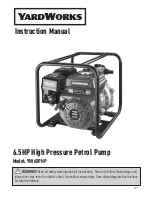
6
INSTALLATION
6.1 General Information
As a rule, the unit must be installed indoors on a
level, smooth and horizontal surface. The entire base
frame should thereby make close contact with the
surface in order to ensure adequate sound
insulation. Failing this, additional sound insulation
measures may become necessary.
The heat pump should be located to allow safe and
easy maintenance/service access. This is ensured
if a clearance of approx. 1 m in front of and to each
side of the heat pump is maintained.
6.2 Sound Emissions
The heat pump offers silent operation due to efficient
sound insulation. To prevent noise transmission to
the foundation, a suitable, sound dampening rubber
mat should be placed underneath the base frame
of the heat pump.
Any sound transmission to the heating systems is
prevented by means of flexible pressure tubing
already integrated into the heat pump.
7
INSTALLATION
MOUNTING
CAUTION!
6
MOUNTING
7.1 General
The following connections need to be established
on the heat pump:
- supply/return flow of the brine system
- supply/return flow of the heating system
- power supply
7.2 Connection on Heating Side
The heating system must be flushed
prior to connecting the heat pump.
Before completing the heat pump connections on
the heating water side, the heating installation must
be flushed in order to remove any impurities that
may be present, as well as residues of sealing
material, and the like. Any accumulation of deposits
in the condenser may result in a total failure of the
heat pump.
Once the installation on the heating side has been
completed, the heating system must be filled, de-
aerated and pressure-tested.
Heating water minimum flow rate
The heating water minimum flow rate through the
heat pump must be assured in all operating states
of the heating system. This can be accomplished,
for example, by installing a differential pressure-free
manifold or an overflow valve. The procedure for
setting an overflow valve is described in the Chapter
Commissioning.
Frost protection for installations prone to frost
Provided the controllers and circulating pumps are
ready for operation, the frost protection feature of the
controller is active. If the heat pump is taken out of
service or in the event of a power failure, the system
has to be drained. In heat pump installations where
a power failure cannot be readily detected (holiday
house), the heating circuit must contain a suitable
antifreeze product.
1 m
1 m
1 m
Summary of Contents for SI 11CS
Page 39: ...39 Notes ...







































